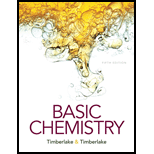
(a)
Interpretation:
The atomic symbol for the element should be determined.
Concept Introduction:
The
The mass number represents the sum of the number of protons and neutrons in the nucleus of an atom.
(b)
Interpretation:
The atomic symbol for the element should be determined.
Concept Introduction:
The atomic number represents the number of electrons revolving round the nucleus in an atom. It also represents the number of protons in the nucleus of an atom.
The mass number represents the sum of the number of protons and neutrons in the nucleus of an atom.
(c)
Interpretation:
The atomic symbol for the element should be determined.
Concept Introduction:
The atomic number represents the number of electrons revolving round the nucleus in an atom. It also represents the number of protons in the nucleus of an atom.
The mass number represents the sum of the number of protons and neutrons in the nucleus of an atom.
(d)
Interpretation:
The atomic symbol for the element should be determined.
Concept Introduction:
The atomic number represents the number of electrons revolving round the nucleus in an atom. It also represents the number of protons in the nucleus of an atom.
The mass number represents the sum of the number of protons and neutrons in the nucleus of an atom.
Want to see the full answer?
Check out a sample textbook solution
Chapter 4 Solutions
Basic Chemistry (5th Edition)
 ChemistryChemistryISBN:9781305957404Author:Steven S. Zumdahl, Susan A. Zumdahl, Donald J. DeCostePublisher:Cengage Learning
ChemistryChemistryISBN:9781305957404Author:Steven S. Zumdahl, Susan A. Zumdahl, Donald J. DeCostePublisher:Cengage Learning ChemistryChemistryISBN:9781259911156Author:Raymond Chang Dr., Jason Overby ProfessorPublisher:McGraw-Hill Education
ChemistryChemistryISBN:9781259911156Author:Raymond Chang Dr., Jason Overby ProfessorPublisher:McGraw-Hill Education Principles of Instrumental AnalysisChemistryISBN:9781305577213Author:Douglas A. Skoog, F. James Holler, Stanley R. CrouchPublisher:Cengage Learning
Principles of Instrumental AnalysisChemistryISBN:9781305577213Author:Douglas A. Skoog, F. James Holler, Stanley R. CrouchPublisher:Cengage Learning Organic ChemistryChemistryISBN:9780078021558Author:Janice Gorzynski Smith Dr.Publisher:McGraw-Hill Education
Organic ChemistryChemistryISBN:9780078021558Author:Janice Gorzynski Smith Dr.Publisher:McGraw-Hill Education Chemistry: Principles and ReactionsChemistryISBN:9781305079373Author:William L. Masterton, Cecile N. HurleyPublisher:Cengage Learning
Chemistry: Principles and ReactionsChemistryISBN:9781305079373Author:William L. Masterton, Cecile N. HurleyPublisher:Cengage Learning Elementary Principles of Chemical Processes, Bind...ChemistryISBN:9781118431221Author:Richard M. Felder, Ronald W. Rousseau, Lisa G. BullardPublisher:WILEY
Elementary Principles of Chemical Processes, Bind...ChemistryISBN:9781118431221Author:Richard M. Felder, Ronald W. Rousseau, Lisa G. BullardPublisher:WILEY





